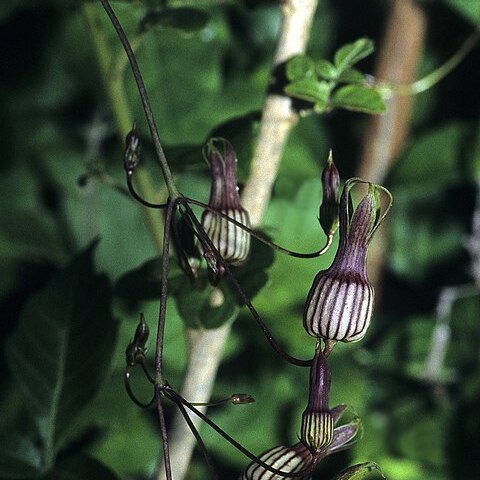A mostly glabrous leafy climber, 2 m or more high. Stem produced annually, twining, sparingly branched, stout in older parts, hollow at centre when dry; nodes slightly swollen; internodes 70-190 mm long, 2-4 mm diam., glabrous or occasionally thinly unifariously puberulous. Leaves herbaceous, spreading; petiole 40-50(-80) mm long, terete, pubescent along rims of adaxial channel; lamina (23-)60-120(-180) x (16-)40-90(-130) mm, ovate, elliptic-ovate or rarely basal leaves semi-orbicular, base deeply or shallowly cordate, apex acuminate or occasionally acute or apiculate; deeply cordate leaves with a broad subtruncate sinus between the semi-orbicular incurved or overlapping basal lobes; usually glabrous on both sides but with marginal areas and basal parts of main veins minutely scaberulous, margin entire. Inflorescence of branched paniculate cymes, 60-120(-170) mm long; bracts linear-subulate, 1-2 mm long, glabrous; peduncle 1-1.5 mm diam., glabrous, branched at the node into 2 or 3 peduncles and then producing the umbellate cymes but mostly dichotomously or trichotomously branching once or twice before producing flowers; pseudoumbels (5-)15-flowered, many flowers opening simultaneously; pedicels (17-)25-35(-40) mm long, c.0.5 mm diam., long, slender and pendulous with erect flowers, glabrous. Sepals linear-subulate or lanceolate, 2-3 x c.0.5 mm at base, glabrous. Corolla (14-)16-22 mm long, straight, conspicuously striated; tube cylindric, slightly inflated towards base, (7-)10-15(-19) mm long x 4-5 mm diam., longer than lobes; exterior with longitudinal purple, brown, purple-brown or green veins producing conspicuous striations, interior, green/yellow-cream, glabrous throughout; lobes 4-7(-10) x 1-2 mm wide at base, oblong-lanceolate or linear-lanceolate, apically tapering into filiform processes, connate at tips and forming a ± triangular cage-like structure; exterior with purple, brown, purple-brown or greenish striations, interior often yellow-green, glabrous throughout. Corona cupular, width ± twice the height, 1.2-1.6 mm high x c.2.7 mm in diam., subsessile, uniseriate to biseriate, glabrous throughout; outer lobes deltoid, subhorizontally radiating, narrowly channelled at centre, ± confluent at lower level towards base and again at a higher level towards apex, apex entire or notched, teeth parallel; outer lobes sometimes forming a continuous rim even opposite anthers; inner lobes variable in length, rudimentary to ± obsolete or as long as anthers or represented by two tangential ridges confluent with outer lobes; when inner lobes present, dorsiventrally compressed, linear-obtuse, c.1 x 0.2 mm, as long as or shorter than anthers, usually thin and very closely applied to their backs and connivent over them; guide rails, c.400 ?m long, well exposed, conspicuously cream to yellowish. Pollinarium: pollinia c.300 x 200 ?m, elliptic-oblong with an acute pellucid margin at apex; corpusculum elliptic, c.150 x 70 ?m. Carpels glabrous. Follicles paired, acutely divergent, cylindrical, apically tapering, 100-117 mm long x c.4 mm diam. at centre, glabrous; seed linear-elliptic, dark brown, c.8 x 2 mm with a c.0.1 mm wide paler margin.
More
Perennial herb with rootstock becoming woody, producing slightly fleshy, cylindric roots. Stem twining, up to several m tall, glabrous or sometimes unifariously puberu-lous. Leaves herbaceous, variable in size; petiole up to 50 mm long; blade cordate, acuminate, sometimes over 150 mm long, glabrous or minutely scaberulous on margin. Flowers in cymes up to 80 mm long, bearing (1)2-3 distant umbel-like clusters of flowers, bent in somewhat zigzag manner at nodes, glabrous; pedicels 12-30 mm long, pendulous, flowers erect. Sepals subulate, up to 3 mm long. Corolla with purple, brown or purple-brown veins 15-25 mm long; tube somewhat globosely inflated at base, 10-15 mm long; lobes oblong-lanceolate or linear-lanceolate, tapering into filiform, connate tips, 7-10 mm long. Corona radiating into lobes confluent at their bases, forming broad pockets and bifid or bidentate on entire margin; inner lobes absent or represented by ridges confluent with outer lobes, or rarely by a filiform process. Follicles linear-terete, ±100 mm long, ±5 mm diam., tapering to both ends, with constrictions between seeds.
A climber. It keeps growing from year to year. It can be 5 m long. It has a woody rootstock with fleshy side roots. The leaves vary in size. The leaf stalk is 5 cm long. The leaf blade is heart shaped and can be 15 cm long. It tapers to the tip. The flowers are in clusters with 2-3 distant groups. They are purple or brown. The fruit are narrow follicles 10 cm long by 5 mm wide and constricted between the seeds. It tapers to the ends.
Perennial herb. Stems twining. Leaves petiolate, blade heart-shaped, up to 150 mm long; petioles up to 50 mm long. Flowers: buds abruptly acuminate-tailed; corona of 5 broad pockets confluent at base and with ovate outer margin; inner corona lobes obsolete; corolla green with purple, brown or purple-brown veins; Nov.-Apr. Fruit a follicle.
Twining perennial herb. Flower bud abruptly acuminate-tailed. Corona of 5 broad pockets confluent at base and with ovate outer margin. Inner corona lobes obsolete. Flowers green with purple, brown or purple-brown veins.

